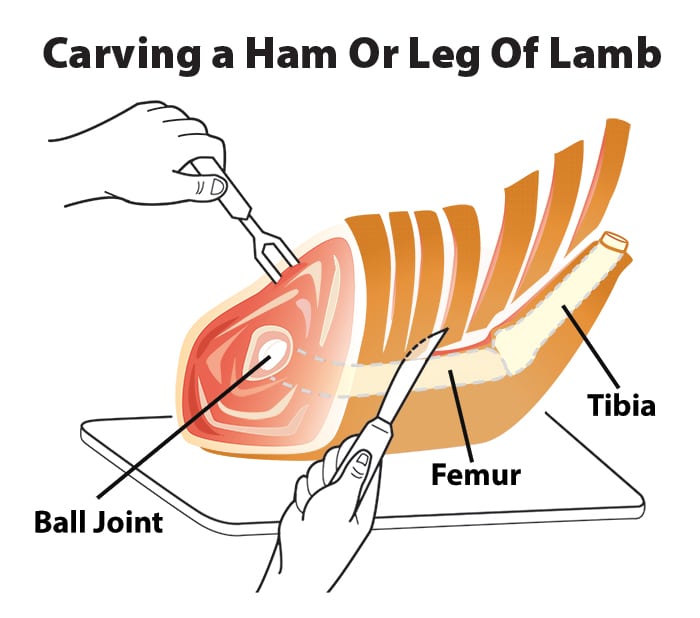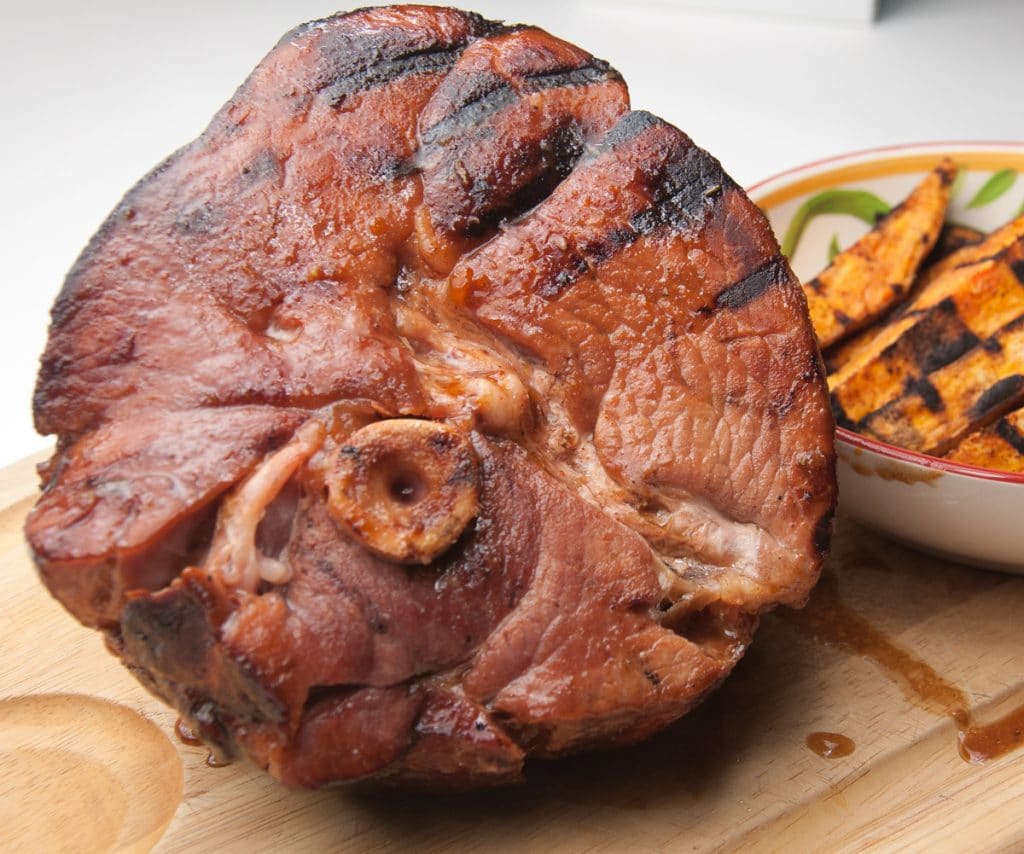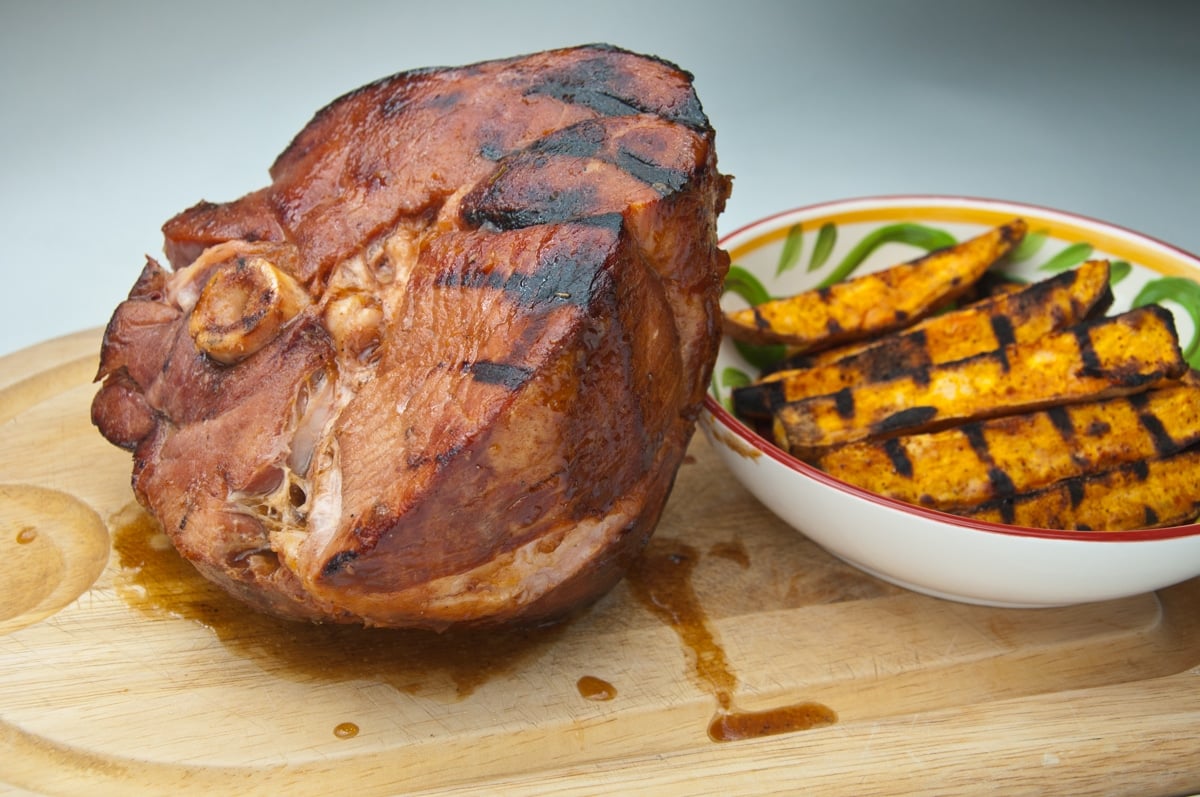Smoked Ham Is Good But Double Smoked Ham Is Better! Here’s The Recipe And Video To Get It Done
Holidays at my house wouldn’t be the same without a ham. But while store bought ham (either whole or spiral) is fine, this recipe for double smoked ham on the grill is a whole other level of flavor. It’s true that smoking a precooked ham may seem like overkill. But the depth of flavor it produces is worth the effort!
How to improve your ham
The problem with most wet-cured hams is that they are dry when you cook them according to the instructions on the package, and the smoke flavor is barely noticeable. So when preparing our double smoked ham, we’ll cook it a lot lower and slower to keep the moisture in, add just a little fresh smoke, wrap it in foil to hold in moisture, sizzle on a glaze, and make a thin sauce that will penetrate the meat and add back moisture.
Once double smoked, you can use the glaze that is packed in with the ham. But I chuck it and use a ham glaze recipe inspired by the great pitmaster, Chris Lilly, executive chef at Big Bob Gibson’s in Decatur, AL, and author of Big Bob Gibson’s BBQ Book: Recipes and Secrets from a Legendary Barbecue Joint. It is a balanced blend of sweet and savory with apricot preserves, honey, brown sugar, mustard, Worcestershire, soy sauce, as well as herbs and spices. There’s a link to the recipe below.
Flying Pigs Ain’t Got Nuthin’ On This Double Smoked Ham! (click here to share this on Twitter).
Remember to save the bone for split pea soup, and if you play it right, there will be leftover ham. That means sandwiches with South Carolina Mustard Sauce, fritatta, Hoppin John beans, eggs Benedict, Hawaiian pizza, ham salad…
Selecting the right ham
The world of hams is confusing, and that’s an understatement, but it is worth getting a handle on things. Just a little knowledge will make your ham dinners much much better.
Hams are cut from the top of the rear legs of hogs, from the knee to the hip, including the big meaty rump muscles, and they can be divided into four broad categories: Fresh hams, dry cured hams, wet cured hams, and injected hams. Alas, when you buy a ham, it most often is labeled something else, like Boiled Ham, Canned Ham, Ibérico Ham, Picnic Ham, Prosciutto, Smithfield Ham, Smoked Ham, Spiral Cut Ham, and Virginia Ham to name a few.
Wet-cured hams
By far the most popular hams in the US are wet-cured hams. These are hams that have been injected with a brine and then pre-cooked. The brine usually has salt, sugar, and spice and lots of stuff nice, and the cooking often includes smoking. This was a method developed for preserving large hunks of meat like hog rumps long before refrigeration was invented.
Wet-cured hams are pinkish purple in color, often have a sweet glaze baked on, and are frequently put on a lathe where a blade can spiral cut them while they are turned. This makes carving them at the table a snap during Easter and other holidays. They usually come in a plastic shrink wrap. If it says “cooked” on the package, you can eat it cold right out of the bag. But cured hams are better served warm with a sweet glaze to counterbalance the saltiness from the brine that was injected into it.
Since wet cured hams are precooked, in theory all you need to do is warm yours throughout, avoid high heat, and avoid cooking too long to keep it from drying. Standard cooking technique on the package and in all the cookbooks says to heat it at 325°F (162.8°C) until it reaches 140°F (60°C) . But that is a “how to” for dry meat. If you take a little care you can really amp yours up to 11 on the grill. (Although the same method works fine indoors).
How to start shopping
If your head is starting to spin, my article, The Science Of Ham, explains almost all the different types of ham. It is worth a read if you ever hope to become a master hamster. First of all, try to find one that has been trimmed properly. You don’t want skin or a thick fat layer. Nobody will eat them, and they don’t add moisture or any flavor to the meat, so it is waste. You want the smoke and the glaze on the meat, not on the skin or fat. Now on to our double smoked ham recipe!
Up your game: Join our Pitmaster Club. Try it out for free for 30 days. No credit card is needed. No spam. Join now and Be Amazing!
Makes:
About 6 1/2 pounds (2.9 kg) meatTakes:
Ingredients
- 8 pounds bone-in precooked wet cured ham
- 1 cup Chris Lilly's Spicy Apricot Glaze
These recipes were created in US Customary measurements and the conversion to metric is being done by calculations. They should be accurate, but it is possible there could be an error. If you find one, please let us know in the comments at the bottom of the page
Method
- Fire up. Prepare your grill for 2-zone cooking and preheat it to about 225°F (107.2°C) on the indirect side. Or fire up your smoker to 225°F (107.2°C).
- Prep the glaze. You can do this step well in advance. Make 1 1/4 cups of Chris Lilly's Spicy Apricot Glaze.
- Prep the meat. If the skin has not been removed, remove it, and trim off almost all the fat leaving no more than a thin layer. The fat does not penetrate the meat (fat is oil, meat is 75% water) and people will just trim it off at the table and there goes your glaze. If it came with a prepackaged glaze, throw it out. If there is a glaze already on the meat, rinse it off. Chris' glaze is better. If it is spiral-sliced, let some water get into the sliced areas to help reduce moisture loss.
- Cook. On a smoker place the meat where it will get the most smoke. On a grill, place the meat on the indirect side flat side down, add a handful or two of wood for smoking as described in my articles on the Best Setup for a Charcoal Grill, the Best Setup for a Gas Grill. Close the lid, and smoke for about 60 minutes.
- Tear off about 6 feet (2 m) of aluminum foil, if you have double strength, that's better. Fold it in half to make it about 3 feet (1 meter) in length. Pour about 4 tablespoons of the glaze into the center of the foil. Take the ham off the cooker, place the flat side on the glaze on the foil making sure you don't puncture the foil with the bone, pour 1/2 of the glaze mix over the meat and spread it all over with a brush. Seal the meat and glaze in the foil making it look like a giant candy kiss. Crimp the seams tight. We don't want any steam escaping or broth leaking. This technique helps it cook faster by generating a little steam, which penetrates faster than dry heat, and keeps the meat moist. If it is leaking, use another layer of foil or place it in a pan. Place it back in the cooker. If you have a leave-in meat thermometer, insert it now through the foil into the fat end above the liquid level, so the tip is about 1 inch (2.5 cm) away from the bone. Watch the oven temp and try to keep it around 225°F (107.2°C). Although if you are in a hurry you can crank it up a bit.
- When the meat temp hits about 130°F (54.4°C), open the foil, paint on more glaze, leave the foil open to catch drips and close the lid. How long will it take to hit 130°F (54.4°C)? That depends on the thickness of the meat and the accuracy of your oven thermometer. As I tend to repeat in every recipe, you cannot trust your grill thermometer no matter how much you spent on your grill, and you need a meat thermometer to tell when the meat is done. Please read my article on thermometers and take action. That said, it could take 3 to 4 hours to hit 130°F.
- Glaze the ham. After about 10 minutes, open the grill, dip your basting brush in the pools of broth/glaze on the foil and paint the meat again. Add more full strength glaze if you wish. Now remove the foil, and pour it into a sauce pan. That's the basis for your sauce. Taste it. Add more glaze or broth as you wish. The thinner it is the easier it soaks into the meat. Don't get too sweet. Keep it warm on the grill or indoors.
- Finish. On a grill, leave the lid open, remove the thermometer and move the ham over to the hot side of the grill and lay it on a curved side so the glaze is facing the heat and the bare meat is not. On a smoker, if you have a gas grill, fire it up na move the ham over the direct heat. Stand right there and watch so the glaze does not burn. Don't walk away even to get a beer. Let the glaze sizzle, but not blacken. You are just trying to caramelize the sugars and develop more flavor. After about 3 or 4 minutes, roll it a bit and keep rolling it until all sides have sizzled except the flat side. Leave it bare. By now the temp should have risen to safe temp of 140°F (60°C). Go ahead and check if you want, but trust me, it's there.
- Serve. Place the meat on a cutting board and slice inward towards the bone, not parallel to the bone as in the illustration. Pour the remaining glaze into a gravy boat and serve it alongside the sliced ham.





High quality websites are expensive to run. If you help us, we’ll pay you back bigtime with an ad-free experience and a lot of freebies!
Millions come to AmazingRibs.com every month for high quality tested recipes, tips on technique, science, mythbusting, product reviews, and inspiration. But it is expensive to run a website with more than 2,000 pages and we don’t have a big corporate partner to subsidize us.
Our most important source of sustenance is people who join our Pitmaster Club. But please don’t think of it as a donation. Members get MANY great benefits. We block all third-party ads, we give members free ebooks, magazines, interviews, webinars, more recipes, a monthly sweepstakes with prizes worth up to $2,000, discounts on products, and best of all a community of like-minded cooks free of flame wars. Click below to see all the benefits, take a free 30 day trial, and help keep this site alive.
Post comments and questions below
1) Please try the search box at the top of every page before you ask for help.
2) Try to post your question to the appropriate page.
3) Tell us everything we need to know to help such as the type of cooker and thermometer. Dial thermometers are often off by as much as 50°F so if you are not using a good digital thermometer we probably can’t help you with time and temp questions. Please read this article about thermometers.
4) If you are a member of the Pitmaster Club, your comments login is probably different.
5) Posts with links in them may not appear immediately.
Moderators